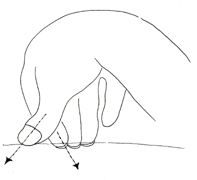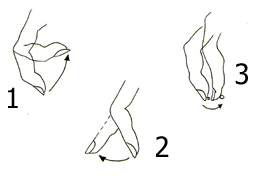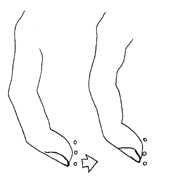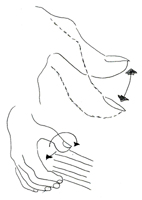Right Hand Classical Guitar Technique
The right hand has to produce sounds determining volume and timbre peculiarities, but it has the task to stop sounds as well. Volume depends on finger strength, it has to be compact and solid when touching the string from knuckles and phalanxes. Timbre depends on nails shape and right hand position. Studing timbre means to study right hand continued movement and it means to study your nails shape too.
The classical guitarist will have to experiece :
1) timbre dolce or sweet or dark (right hand over the 16th key)
2) timbre aspro or metallic (right hand next to the bridge)
3) timbre naturale (right hand over the hole)
When touching a string the concact has to happen on your finger tip and then on your nail: nails are indispensable to reach a strong and pure sound.
You'll need short nails, they sould be flat and attached to your fingers tips. If your nails are bended you'll have to experience a longer shape and sometimes you'll have to play just with your nails.
You'll need a wide nail shape, it is basic to reach pure sounds: avoid triangular or chapel like nails shape. File down your nails to cut off edges and smooth them using a piece of leather.
Try to figure out that you have to hit the string to press it down and not to pull it up or tear it.
Fir is the quickest wood for vibrations spreading and then there is cedar tree.
Remember that increasing string release speed, superior harmonics will increase as well, that's why sound will be more metallic like: to obtain darker sounds you'll have to slow down the string release.
How to obtain Metallic Sound (Full Harmonics) :
1) right hand next to the bridge
2) playing fast the string
3) choosing fingerprints with several free strings
How to obtain Dark or Sweet Sound :
1) right hand over the hole or over the keyboard
2) playing slow the string
3) choosing fingerprints with few free strings
Picking a string two times in the same point with the same action but different strength will produce a purer sound thanks to the less energy applied.
There are two kinds of stroke : free stroke and rest stroke
Free stroke is mainly used for arpeggio, rest stroke (or apoyando) is mainly used for increasing scale volume. Rest stroke requires a well-trained right hand.
Right hand high view

Three frequent errors

1 - claw like mouvement, 2 - ahead phalanx mouvement, 3 - passive phalanx downfall
Correct rest stroke mouvement (apoyando)

Correct thumb mouvements

Thumb little hints :
thumb has to come back to its starting position after the picking action using muscular mass between thumb and index.
Practice your thumb playing with no nail as well to change timbre.
Little Mouvements
All guitarists have to act very little mouvements becouse every articulation mouvement has its own theoric minimum mouvement and its own optimal mouvement: it's useless to copy Segovia mouvement becouse you'll have to find your optimal minimum mouvement, that's to say you'll have to find the right mouvent according to your physical characteristics to reach your better sound. You'll have to gain a wide stored mobility so your mouvement will be perfect but little. An example of this should be an athlete : he doesn't bend his legs reaching his face, but he could, that's why he can run so easily and fast.
Rolled Chords
The rolled chord or broken chord is aslo called an arpeggation because this term is now understood by guitar players to mean a written-out separation of the notes of a chord in a definite rhythm, it would be hard to imagine a performance with only blocked armonies.
The history of the rolled chord probably goes as far back as armony. Guitarists should feel free to experiment with this effect and must still decide upon various elements such as the speed of the rool, the direction, the intensity, the rhythmic placement (on the beat, before the beat).
From the baroque period untill nowaday, the roll was performed in a variety of ways.
Segovia seemed to prefere one type of roll from the bottom to the top: this is an aspect of Segovia style quite important, infact a significant percentage of the chords within any given piece were played as rolled chords by Segovia.
You can decide about direction, manner of execution, thumb alone, thumb and fingers, index finger, all nail and nail and flesh.
Speed and exact placement of the roll are all left up to the performer.
Reader Hints:
Emilio Pujol 'El dilema del sonido en la guitarra'
Graham Wade and Gerard Garno 'A new look at Segovia' Mel Bay Publications
Angelo Gilardino 'La tecnica della chitarra'
V. Bobri 'The Segovia Tecnique'
R. Chiesa 'Guitar Gradus'
John W. Duarte 'The bases of classic guitar technique'
All topics remaining regarding the right hand are the follopwings:
1) Stoppato or pizzicato or palm muting;
2) Staccato;
3) Sound stopping;
4) Rasgueado;
5) Relaxation and support points;
Stoppato or Pizzicato
Stoppato is to put the right hand palm on the bridge and then turn the wrist untill the thumb will be on top of the sixth string: doing like this the palm will stop strings vibration and the bass sounds will result thump: Andres Segovia often applied this effect.
You'll have to practice playing a chromatic scale with your thumb on bass strings.
Watching 'La Alborada' video you will see my way to use the stoppato effect and besides my way to play the harmonics just with my right hand and the slurs with the left hand.
Sound Stopping
Stopping sound is another task for the right hand, it happens shutting the strings vibration. One sound is turned off due to musical reasons, rhythm reasons or harmonic unsuitable reasons concerning subsequent sounds (open strings vibration or vibrancy).
Sounds can be stopped by
1) Hand palm
2) One finger stopping one vibrating string coming from a lower string (i,m,a) or coming from a higher string (thumb) applying the rest stroke.
3) Resting the thumb on a string after touching it.
4) Resting the thumb on one or two strings shifting left.
This processes can be applied while others fingers make other sounds. The thumb can stop a sound while making another one from the lower string too.
I know, it is not easy to explain classical guitar technique by words, that's why I hope you'll find usefull to watch my videos on this site.
Rasgueado
We can define the Rasgueado as a reverse sound emission and we obtain it beating the strings from the 6th to the 1st string (using A M I) and (using P or thumb) from the 1st to the 6th. You'll have to mantain your fingers posture solid and compact and your mouvement will be driven by your knuckles and phalanxes. Rasgueado can touch three or six strings and you can do the rasgueado technique with the I A M sequence as well.
We can think about rasgueado as a usefull gymnastic to reinforce the right hand and to play better all kinds of arpeggio.
Right hand Relaxation
Right hand relaxation is a good hint for whom has a strong right hand but when we have to play loud or louder or if the right hand is weak some tension is usefull: when your fingers are weak yuo'll get poor sounds and you'll have to reinforce your fingers muscles, for examples you can exercice on "120 Arpeggi" by Mauro Giuliani.
Support points
The former guitarists were used to attach the little finger on the board or on the bridge. Now a day we can't use this help no more becouse the timbre dynamic and technique as well want more right hand action: the support can exist only inside the right hand itself. You'll have to keep your thum and little finger opened to external supports and you'll get an opposition in your right hand palm working as support point. Keep on exercice on arpeggio, and try to figure out there is a gum ball in your hand palm and try to squeeze it.
Artificial Harmonics
To obtain artificial harmonics you'll have to press with your left hand the first E string at the first fret and lean lightly against the XIII fret your index finger (i). Then you'll have to play using your ring finger (a). When playing basses you could play using your thumb too. If you need to play others notes along with harmonics as it happens playing Spanish Dances by E. Granados you'll have to play the second string B using your medium finger (m).
'Armstrong Moon' composed by Daniele Magli: you can this piece as an open strings exercice to improove your right hand technique. It's rather difficoult to sincronize the right and the left hand, but this exercice will make your hands more indipendent by far. Don't forget to tune the sixth string on D.
Armstrong Moon
'Ghost' composed by Daniele Magli is a piece for practcing with the guitar staccato technique. You can apply the staccato technique sometimes with the right hand, sometimes with the left hand. This is why I suggest you to watch carefully at the video and read the free .pdf score.
Ghost
Apollo 11 it's a piece for classical guitar composed and played by Daniele Magli with the plectrum thumb technique called Alzapua (from Flamenco guitar techniques: the alzapua use the thumb as a pick here also apoyando with index finger).
Apollo 11
All free .pdf scores about Daniele Magli music and tips HERE
Check out the Daniele Magli's classical guitar blog at https://danielemagli.blogspot.com
We will add further detaiks assoon as possible...
|
|
|
|